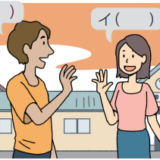3.ありがとうございます
人にお礼を言ったり、謝ったりすることができる。
Can thank someone or apologize to them.
1.会話を聞きましょう。
Listen to the dialogs.
▶いろいろな場面で、お礼を言ったり、謝ったりしています。
The people are each saying thank you and / or apologizing in different situations.
Saying thank you. お礼を言う
(1)①-⑤では、どんなことばでお礼を言っていますか。a-dから選びましょう。
What words are the people using to say thank you in ①–⑤? Match the words given in a–d.

① a
ありがとうございます。
Arigatoo gozaimasu.
Check the words and listen to the dialogs again.
(2)ことばを確認して、もういちど聞きましょう聞く
- これ【kore】this
- あめ【ame】candy
- プレゼント【purezento】present
- どうぞ【doozo】Here you go.
- いいえ【iie】You’re welocome
- 落としましたよ【otoshimashita yo】You dropped this.
- わあ【waa】Oh!(express surprise)
Look at the illustrations and listen to the dialogs again.
(3)イラストを見ながら、もういちど聞きましょう。聞く
(1)のa-dのことばは、どんなときに使うと思いますか。
Look at the illustrations and listen to the dialogs again. When do you think you use the words in (1) a–d?
・「a.ありがとうございます」がいちばんフォーマルで、きちんとお礼を言う必要がある場面で使う。
a.”Arigatou gozaimasu” is the most formal and is used in situations where it is necessary to express gratitude properly.
・「c.(どうも)ありがとう」はそれよりもカジュアルな場面で、友だちなどに使う。
c.” (Doumo) arigatou” is more casual and is used among friends.
・いちばん短い「d.どうも」はよりカジュアルで、軽いお礼のときに使う。
The shortest “d. Doumo” is even more casual and is used for light expressions of thanks.
・また、相手に負担をかけたような場面では「b.すみません」をお礼の表現として使う。
Also, in situations where you feel you have caused a burden to the other person, “b. Sumimasen” can be used as an expression of gratitude.
Apologizing 謝る
(4)⑥-⑧では、どんなことばで謝っていますか。e-fから選びましょう。
What words are the people using to apologize in ⑥–⑧? Match the words given in e and f.

⑦ f
A:あ、ごめん!
A, gomen!
B:あー!
Aa!

⑧ e
A:すみません……。
Sumimasen…
Check the words and listen to the dialogs again.
(5)ことばを確認して、もういちど聞きましょう。聞く
- 痛い!【itai】Ouch!
Look at the illustrations and listen to the dialogs again.
(6)イラストを見ながら、もういちど聞きましょう。聞く
(4)のe-fのことばは、どう違うと思いますか。
Look at the illustrations and listen to the dialogs again. What do you think the difference is between the words in (4) e and f?
・「e.すみません」のほうがフォーマルで、「f.ごめん」はインフォーマルな場面で使われる。相手があまりよく知らない人や目上の場合は「e.すみません」を使い、友だち同士であれば、「f.ごめん」を使う。
“e. Sumimasen” is more formal and “f. Gomen” is used in informal situations. When speaking to someone you don’t know well or to someone higher in status, use “e. Sumimasen”, and use “f. Gomen” when speaking with friends.
お礼を言ったり、謝ったりしましょう。
Say thank you and / or apologize.


Listen to the dialogs.
(1)会話を聞きましょう。
Listen to the dialogs.
(2)シャドーイングしましょう。
Shadow the dialogs.
(3)1.(1)のイラストを見て、練習しましょう。見る
Practice using the illustrations from 1(1).
1.(4)のイラストを見て、練習しましょう。見る
Practice using the illustrations from 1(4).
(4)場面を自由に考えて、お礼を言ったり謝ったりしましょう。
Freely think up a situation and say thank you and / or apologize.
\ IRODORI Japanese Online Course /













